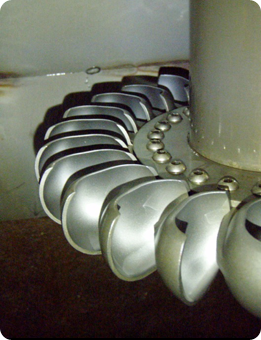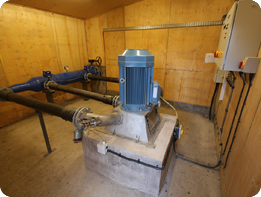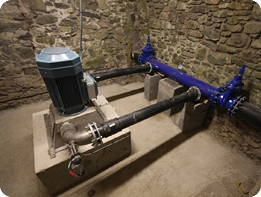Technical
Hydro power uses the energy of falling water to create electricity. Whether a site is suitable or not depends on whether there is a combination of sufficient flow and ‘head’ (the vertical height the water drops). Generally, for the high head turgo sites we deal with, a head in excess of 15 metres is required.
Turgo Turbine
Similar in principle to the pelton turbine, jets of water are directed at a runner (stainless steel spoons welded to a disc), forcing the runner to rotate. Multiple jets are often used, up to six in some cases, which gives greater flexibility in the flow rates that can be managed.
Equipment
A micro-hydro system requires:
- An intake for the water, usually a weir with a screen and built-in intake chamber
- A penstock (pipe) through which the water is transported to the turbine
- The turbine itself coupled to a generator
- Control gear to automatically manage the flow rates to the turbine
The turbine, generator and control gear need to be housed in a building normally referred to as the power house.
Power Output
Generally 40% to 70% of the water flow can be abstracted for use in a hydro scheme. The quantity will depend on the ecological rating of the water course. Abstraction & impoundment licences, flood defence consent and planning permission are required for most schemes. The power output of a hydro turbine is proportional to the flow, head and efficiency of the system.
If, for example, 10 litres per second can be used, and there is a 100 metre head, this would be equivalent to a 6kW micro-hydro system. Depending on how the watercourse's flow varies over the year, this could produce in the region of 20,000 to 25,000 kilowatt hours (or units of electricity) per year, which is the consumption of 8 average UK homes.
Hydro can be used for off-grid or grid connected applications.
Costs
Costs vary considerably from project to project, as penstock (pipe) runs are very site dependent and so is the size of the weir. Costs can vary from £2,000 to £10,000 per kilowatt.
As an example a 6 kilowatt system with 100 metre head and 10 litres per second flow, might cost in the region of £40,000 to £60,000 depending on the distance over which the fall takes place.

A stainless steel runner from a turgo turbine. The spoons shown are where the jets of water impact, forcing the runner to rotate.

Generator directly coupled to a three jet turgo turbine below it.

This 15kW turbine is capable of generating enough electricity for 18 average UK homes.
